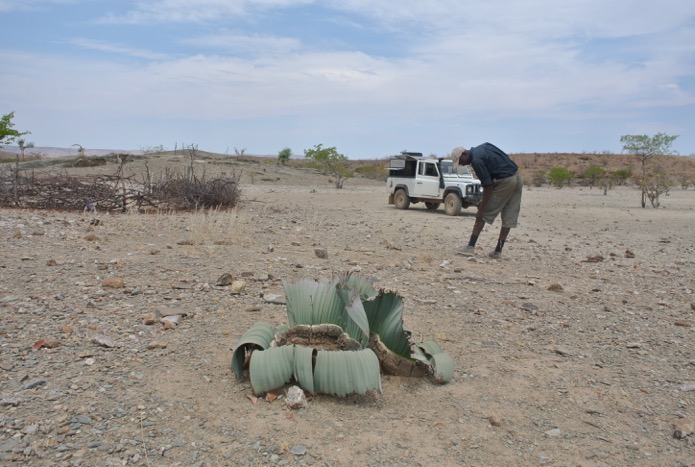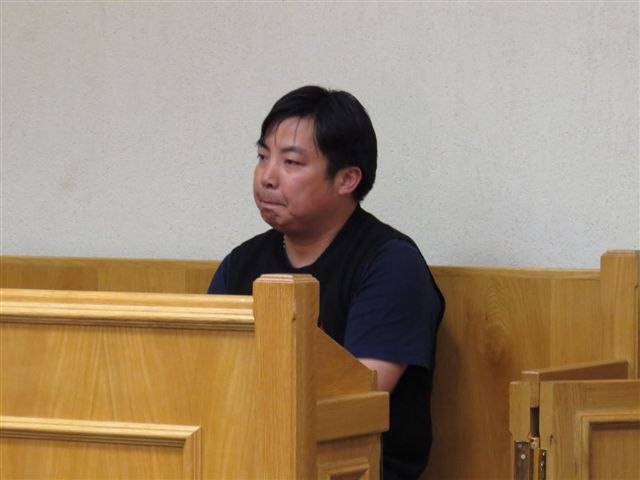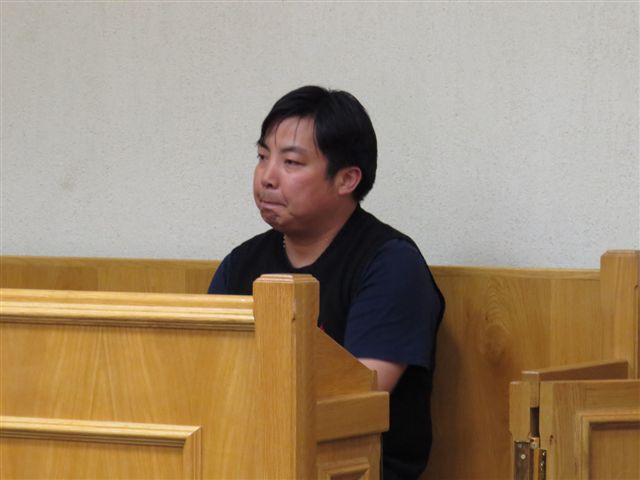
17 Jul Caught in the crossfire: how cattle and Chinese mining interests are killing off Namibia’s black rhinos
A 10-month-long investigation by John Grobler uncovers the political and commercial agendas driving the world’s largest black rhino population towards extinction
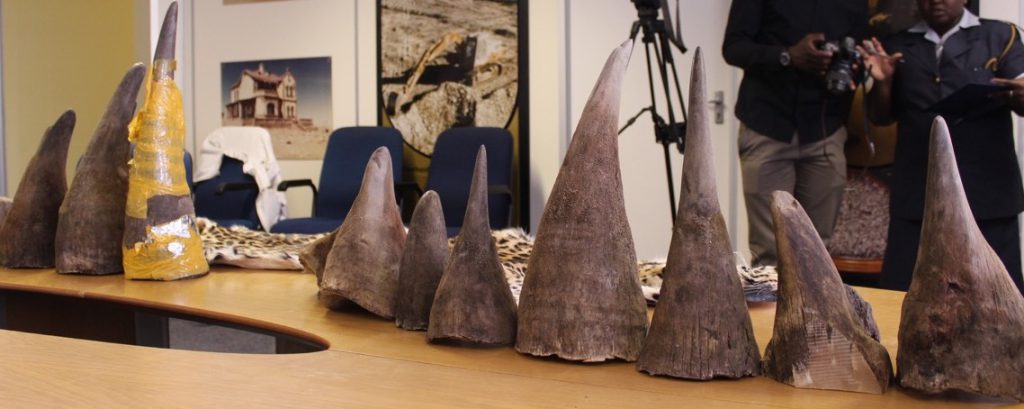
Fourteen rhino horns were found in the luggage of three Chinese couriers in March 2014. DNA tests showed 13 of the horns originated from Kunene
Namibia’s black rhinos and the OvaHimba people’s way of life in the remote north-western Kunene Region are under grave threat from a deadly combination of corruption, a prolonged drought, multi-billion Chinese mining and construction ventures, and land-hungry communal cattle farmers, leading to the sharpest upsurge in rhino mortalities in 30 years.
In the political showdown between conservation and industrialisation playing itself out along the Red Line veterinary fence in northern Namibia, the world’s last free-roaming black rhinos are caught in the crossfire of a larger battle between East and West for natural resources – and the rhinos are losing.
Poaching of the critically endangered species started in 2008 in the Etosha National Park, and surged in neighbouring Kunene from 2012. Combined with mortalities ascribed to natural causes, Namibia over the past three years lost a quarter of its black rhinos, which make up 40 percent of the world’s surviving population.
In each instance, the upsurge in poaching coincided with the influx of Chinese construction-cum-mining teams into formerly undeveloped rural areas in close proximity to game parks, brought in by state construction projects agreed to in 2006 and 2007 between China and Namibia, and systematically implemented via party structures of the ruling South West Africa People’s Organisation (SWAPO) Party and Chinese Communist Party.
The deals point to a convergence of mutually beneficial financial and political objectives in opening up the country’s last pristine wilderness area to Chinese and other foreign mining companies eager to exploit untapped iron and copper ore deposits by tapping the hydro-electric capacity of the Kunene river on the northern border with Angola.
All the infrastructure deals share similar features: politically driven projects at hugely inflated costs, often financed by concessional loans from the China Exim Bank and fronted by key SWAPO members of the “Omusati Clique”, characterised by their cult-like reverence for Namibian founding president Sam Nujoma and for accumulating wealth.
HYDRA-HEADED DRAGON FROM JIANGSU
An analysis of all the Chinese companies involved showed them to be part of a bewildering 50-odd state-owned mining and construction companies, all resorting under the Eastern China Geological & Mining Organisation for Non-Ferrous Metals (“ECE”), mostly from Jiangsu Province. Five of the main Chinese companies active in both road construction and mining all share one telephone number and one manager in Namibia, Li Ming, an analysis of mining records and telephone records showed.
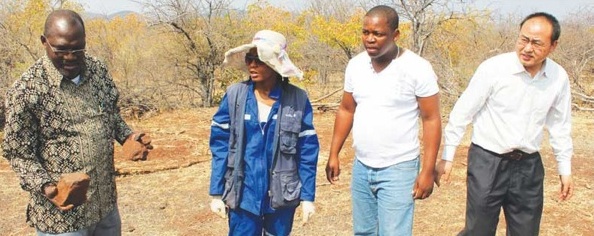
A photo from the New Era newspaper in September 2012 shows Li Ming (right) with Deputy Minister of Trade and Industry Tjekero Tweya (right), geologist Bridget Tshioma and project coordinator Steyn Mbunga at an iron ore site
ECE’s rumoured closeness to Nujoma prompted it to issue a rare press release noting that “[…] the support from Dr Sam Nujoma represents his high concern on the economic development of Namibia. During the previous meeting with Dr Sam Nujoma, he diplomatically and out of his good will gesture, politely accepted the suggestion put to him of being the honorary advisor of ECE and NOT the Honorary Consultant. Hence this suggestion has not been formalized.” (sic)
All the Chinese suspects arrested thus far also hail from Jiangsu province and its capital Nanjing, an Autonomous Region known as “China’s second capital” and historically known for its trade in luxuries such as jade, rhino horn and ivory. Nanjing, China’s second wealthiest metropole after Shanghai, is also home to the People Liberation Army’s five key political and military academies – a fact that appears to have direct bearing on how the Chinese syndicates in Namibia are organised.
On the ground, the Chinese leave little official footprint: since 2000, when he started renting out apartments and shop-space to Chinese tenants, he was yet to see any copy of identity documents. Always cash, and always on time, said Sakkie Burger of Otjiwarongo, where the suspected Chinese kingpin Hui Wang ran several businesses since 2007.
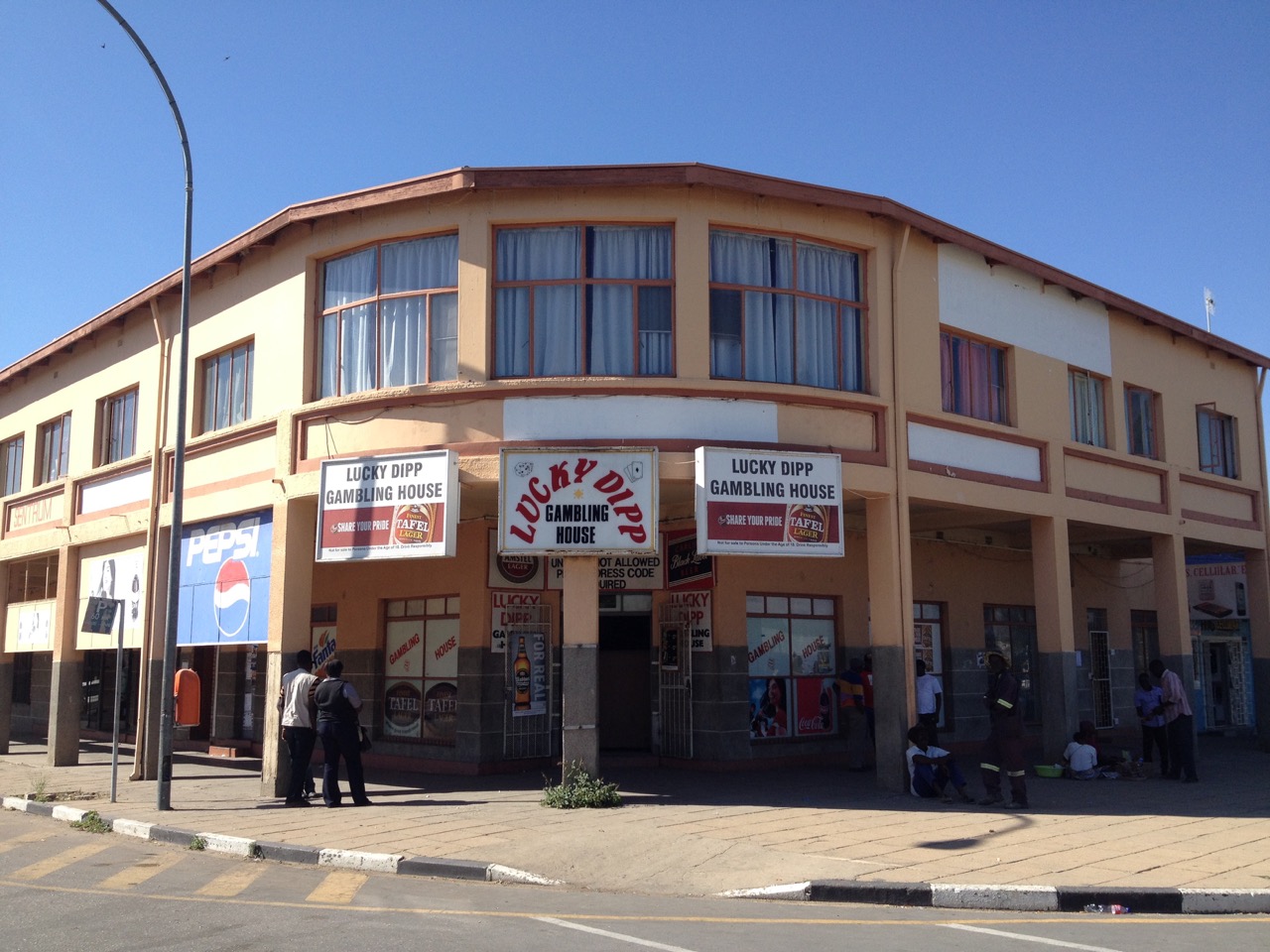
Apartments in Otjiwarongo where Hui Wang lived and where the couriers spent several days in March 2014
Wang, who had been renting several properties from him since May 2006, appeared to be hiding money in US dollars in the wall power sockets, he said. “He complained about a robbery one day and I arrived there to find him opening all the power sockets – looking for his money, he said,” Burger recalled.
None of the five Chinese tenants on his books ever showed any identification, and he was not quite sure who they really were. “It’s like they have a relay system: a new guy comes in, stays a month and then the old one goes up to Oshikango [on the border with Angola] or back to China,” said Burger. “You never really know who is living there.”
ROADS, RED LINE AND CATTLE
Politically, all the tracks led through the doors of the Ministry of Works and Transport, the main source of all big infrastructure contracts and associated political patronage as political line ministry overseeing all state-owned enterprises responsible for all road, rail and harbour infrastructure.
And on the killing fields of Kunene, complicity with poaching was closely associated with political jostling for control of the vast but sparsely populated region ahead of last year’s general elections. These elections saw pro-conservation opposition parties defeated for the first time since 1989 by pro-mining, cattle-farming players aligned to SWAPO.
Overall, the process was characterised by Chinese incentives (pushing mining while also associated with rhino poaching) and a fundamental conflict between Namibia’s conservation and land use policies that was exploited for political and financial gain.
A key political driver in the rhino poaching was the growing land hunger among communal Oshiwambo-speaking people, who comprise 49 percent of Namibia’s population and dominate the ruling party.
About 70 percent (1.4-million) of Namibia’s total cattle herd ranges north of the veterinary cordon fence, the “Red Line”, that separates communal and commercial areas to prevent the spread of communicable bovine ill-nesses such as foot-and-mouth disease and bovine pneumonia.
First imposed by the German colonial administration in 1897 to prevent rinderpest (cattle plague) from spreading south, the Red Line also prevents communal farmers from moving their cattle south into better winter rangelands. This has led to serious land degradation due to over-grazing, with the loss of up to a metre of topsoil since 1990 in areas of western Omusati immediately adjoining Kunene.
“Land degradation is THE major unrecognised cause for modern day expansion and occupation of land belonging to present day disadvantaged [people],” said veteran geo-hydrologist Frank Bockmuhl of the area.
RISING RHINO MORTALITIES
The Ministry of Agriculture, however, is obliged to maintain the Red Line fence as a legal condition for Namibia’s quota for beef exports to the European Union. But when a recent foot-and-mouth disease outbreak in the northern communal areas triggered a quarantine of all cattle behind the veterinary cordon fence, it emerged that it had not been maintained since independence from South Africa in 1990, with large sections completely missing in the west.
The pro-cattle agenda is also clear from the Ministry of Environment and Tourism’s neglectful management of Etosha National Park, which forms part of the Red Line as a buffer zone.
During the foot-and-mouth disease crisis it also emerged that large sections of the elephant-proof fence around Etosha were missing, with communal farmers grazing their cattle inside the park along the northern and western boundaries.
Overall, the effect has politically undermined conservation in communal areas, while simultaneously advancing interests aligned to turning Kunene into a mining Mecca – mostly for Chinese state-owned companies.
With SWAPO now in political control of Kunene since last year’s elections (which helped remove the last resistance to the controversial Baynes hydro-electrical scheme planned for lower Cunene River), all signs are that a Chinese mining juggernaut will soon overrun this ruggedly beautiful area, with dire consequences for the wildlife and the OvaHimba.
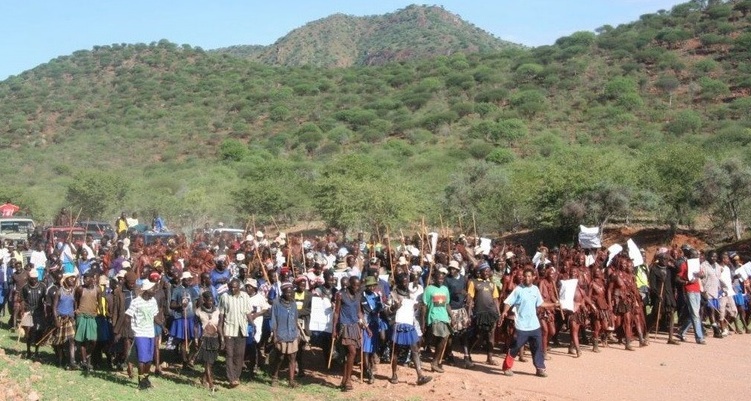
OvaHimbas and Zemba protest against government plans to build Baynes Dam, March 2014. Photo courtesy Earth Peoples
So far, the Kunene’s black rhinos have been the main victims. Over the past 10 years, 392 black rhinos have died (or nearly 20% of the total population), half of those mortalities occurring over the past two-and-a-half years. Of those, 50% were poached, 60 in Etosha in the past six months, according to statistics released by the Ministry of Environment and Tourism (MET).
Namibia is home to about 40% of the world’s 5,000 surviving black rhino population, which once numbered as many 850,000 in Africa in the early 20th century, according to the International Union for Conservation of Nature (IUCN). Namibia also has a smaller white rhino population of about 500, mostly privately owned, with minimal poaching losses reported – eight since 2013.
HOW IT STARTED: ROADS, RAILWAYS AND CHINESE MINES
Historically, the Chinese arrival in Kunene followed a no-bid, US$105-million road upgrading project in the region in 2012 in favour of China Mechanical Engineering Corporation (CMEC) and China Gezhouba Group International (CGG).
A similar road upgrading project, also in 2012 in north-eastern Zambezi Region (formerly known as Caprivi), in favour of Metallurgical Company of China (MCC), also marked a sharp increase in the area of poaching of elephants and other endangered species such pangolins and carmine bee-eaters for consumption in China, local conservationists said.
Between 2012 and 2015, various Chinese state-owned mining companies – mostly part of the sprawling East China Geological & Mining Organisation for Non-Ferrous Metals (ECG) – obtained an estimated 58 percent of all Exclusive Prospecting Licences (EPLs) in Namibia. This figure approaches 80 percent or more for the Kunene now, according to an analysis of the Ministry of Mines and Energy’s EPL database.
China already owns the largest uranium mine in Namibia, the Swakop Uranium Husab project that is to go into production in 2016. Husab’s majority shareholder is the China International Nuclear Corporation, with the Namibian state-owned Epangelo Mining holding a 25% share.
However, developing new mines in Namibia, a largely arid country, is severely constrained by a shortage of water and electricity. In the Kunene, a lack of road and rail infrastructure poses further problems. The government hopes to overcome these hurdles by building a new hydro-electric scheme on the Cunene river, and have taken on Chinese concessional loans to start constructing new, tarred roads into the area.
Work on the final 62km extension of the Tsumeb-Ondongua railway line into southern Angola has also resumed, the Ministry of Works and Transport confirmed. Built largely at Nujoma’s behest during his last term in office, the project had stalled since 2009 when it emerged China National Machinery & Equipment Import and Export Company (CMEC) was about to over-charge Namibia by more than N$1-billion.
CMEC will now do the work for N$597-million, while their South African competitors offered to do the same work for N$250-million, one of the unsuccessful bidders said.
Similarly, a no-bid contract was awarded by former Works Minister Helmut Angula to CMEC and CGG to upgrade two roads in Kunene at nearly double the current rate.
CMEC was also the supplier of faulty and sub-standard locomotives and rolling stock to Namibia’s technically bankrupt rail operator, TransNamib, for use on the Tsumeb-Ondongwa line.
The line and the heavily promoted Ongulumbashe Express service between Windhoek and Ondangwa have been a commercial failure since the CMEC locomotives, designed for short-haul service, ceased to function within months of commencing operations.
THE CAPITULATION OF CHIEF KAPIKA
Like the failed Tsumeb-Ondongwa railway line, the proposed Baynes Dam and Cape Fria harbour are all pet projects of Namibia’s founding president and part of his Vision2030 developmental blueprint, adopted as official government policy,
The biggest boondoggle in the works, however, is the Baynes hydro-electric power station. Paulinus Shilamba, MD of Namibia’s state-owned power utility company Nampower, recently confirmed that the construction of Baynes Dam on the Cunene River would commence in 2018. Nampower planned to borrow up to N$40-billion (US$3.3-billion) on the open market for the project, he said. This is a vast price escalation from the estimated N$6.5-billion, submitted in 2011 to the regional Southern African Development Community.

Nampower recently confirmed construction of Baynes Dam on the Cunene River would commence in 2018
The Baynes project has since 1995 been blocked by the refusal of local Ovahimba Chief Hikuminae Kapika of Orokawe, whose steadfast resistance even to Nujoma’s personal overtures has made him something of a folk hero. Following persistent overtures by two Namibian businessmen, Justice Tjirimuje and Mervin Hengari, and the Chinese manager of the future dam construction project, a 14-person delegation was treated to a lavish, all-expenses-paid trip to China in 2013.
Upon their return, they were kept for three months at Tjirimuje’s farm near Okahandja where offers of cattle and cash were reportedly made. In March 2014, two non-governmental organisations battling against the development made it known that Kapika’s resistance to protecting his people’s way of life had finally crumbled.
The 87-year-old Kapika was immediately replaced by his tribal constituents, and he remains under an armed police escort that prevents him from speaking to any of his people on his own, Ovahimba people from Orokawe said.
In March 2015, Tjirimuje and Hengari were acquitted of corruption for allegedly attempting to influence the top Mines and Energy official, Joseph Iita, on the Tender Board to award another big dam construction project to Italian construction company, Impregilo. The High Court heard that Impregilo has since bought out Salinas Sprl. after Salinas won the tender.
CHINESE COURIERS AND THE OTJIWARONGO CONNECTION
As with the graft in railways, roads and dam construction contracts, the illegal trade in rhino horn also appears to be driven by Chinese players, who are offering up US$15,000 in finder’s fees plus US$10,000 per kilogram of rhino horn, police informants said.
The first poaching since 1993 of a rhino cow in Kunene was reported in December 2012. In 2013, another case was reported, while deaths attributed to natural causes surged to three times the norm. By the end of 2014, 49 of these unique rhinos had died, 20 confirmed as result of poaching.
Six Chinese citizens have so far been arrested on charges of illegal possession of rhino horns, including three men arrested with 14 rhino horns in their luggage at the Hosea Kutako International Airport in Windhoek in March 2014. Of these 14 horns, DNA tests showed that 13 originated from Kunene, Bernd Brell, Save the Rhino Trust director of special operations, testified in court in August last year.
Wang Hui, a 41-year-old Chinese businessman who police say delivered the suitcases to the three couriers at the Windhoek Country Club, was picked up a year later after he disappeared following the arrest of the couriers, Li Zhibing, Li Xiaoliang and Pu Xuexin, at the Hosea Kutako International Airport. He will now be tried with them at the end of July.
Another suspect, Xu Deijin, arrested in Opuwo in 2013, had a warrant for his arrest issued after he failed to appear for a scheduled hearing last month. It was further established that Wang has two passports, and police sources said he may also have a Namibian passport.
Wang and another Chinese suspect, Tianshi Health Products MD Paul Hoa, both arrived in Namibia around 2000 as Chinese foreign investors. Hoa is the partner to Omusati businessman Efraim Muanyangapo, who was fingered by convicted poacher Tjihuuere Tjiunda. Tijunda killed the first rhino in 2012, claiming that Muanyangapo offered him N$30,000 for rhino horns.
ADMINISTRATIVE WEAKNESS, THE DEUX EX MACHINA
Arrests of poaching suspects have been slow, mostly because the Protected Resources Unit (PRU) had no office in Kunene, was chronically understaffed and lacked resources, its commanding officer Chief Inspector Barry de Klerk said.
Other senior police sources said the situation was compounded by high-level corruption that frustrated efforts to keep the suspects behind bars. A case in point is Gerson Kandjii, the former national soccer team doctor who was arrested with four others in November last year in connection with the first poaching cases reported in Etosha.
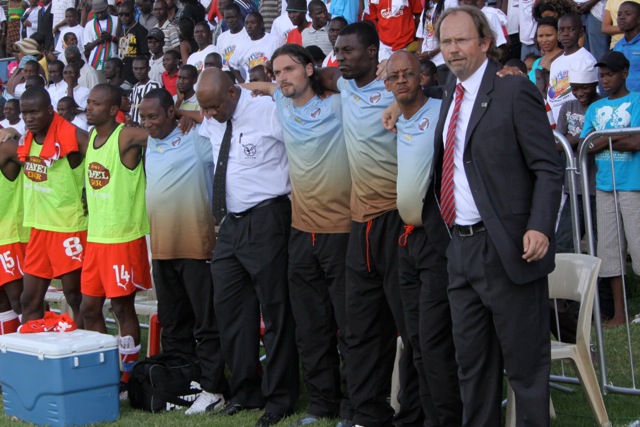
Former Namibian national soccer team medic Gerson Kandjii (third from left) during a match against Botswana in 2010. Photo: Helge Schutz
Although bail was initially refused, his lawyers exploited the weakness of the lower courts to arrange his release on bail by the Okahao Magistrate’s Court in January. Less than two months later, he was again arrested by the Serious Crime Unit following an intense manhunt for the murderer of a retired German industrialist on his game farm about 200km south of Windhoek.
Although bail was refused again, just three weeks later Kandjii managed to obtain bail, to the immense frustration of the police. The ensuing public outcry led to his bail being cancelled, and he was taken into custody again. The Office of the Prosecutor General has since moved Kandjii’s case to the regional capital, Uutapi, because of concern over possible political interference.
It took two-and-a-half more years for more arrests to be made in connection with the poaching of the desert rhino, west of Etosha, and there were no suspects for the vast majority of poaching cases. This included those responsible for killing the rhinos whose horns were found in the luggage of the three Chinese couriers.
$55.3-MILLION X-RAY SCANNERS MARK THE SPOT
The case of Li, Li, Pu and Wang has a significant connection to official deals between Namibia and China: a highly controversial US$55.3-million deal to supply Namibia’s airports and harbour with industrial X-ray scanners.
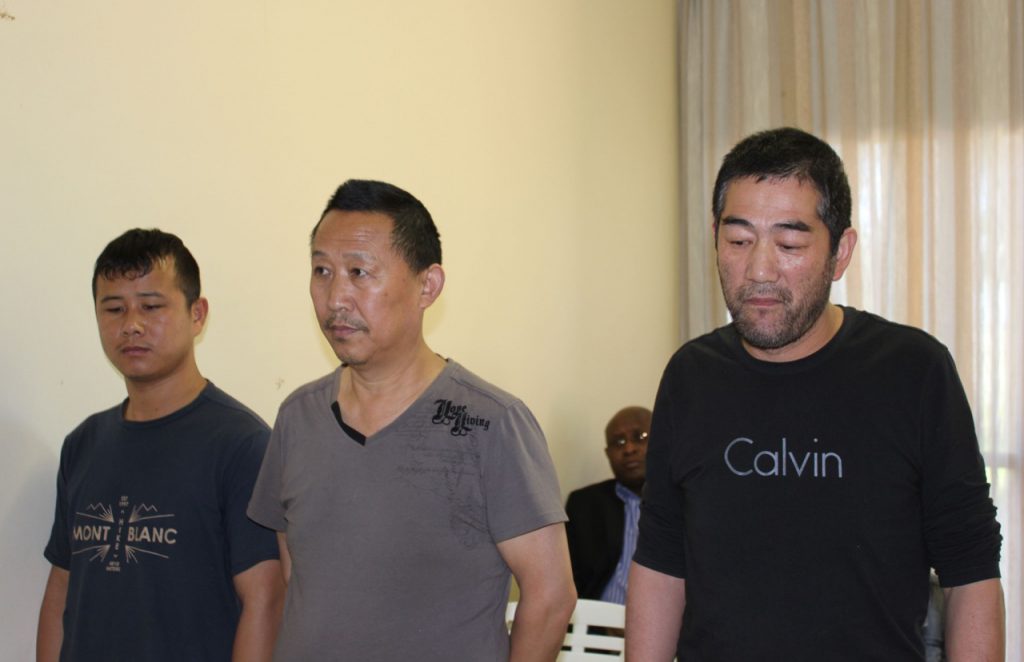
Alleged Chinese couriers Li Xiaoling, Li Zhibing and Pu Xuexin, from Jiangsu province, at their first appearance in court
Like the financing for the Angolan railway extension and Kunene road upgrading projects, the scanners are linked to a revolving line of credit financing package that the Chinese government offered Namibia during former Chinese President Hu Jintao’s brief state visit to Namibia in February 2007. Former Works Minister, Helmut Angula, explained later in 2009 that some of the money was to be used to pay for the scanners, as well as new IT equipment for the Ministry of Home Affairs.
Even though Hu was only in Namibia for 24 hours, he found time to confer for an hour with Nujoma. The former president was quoted in the state-owned New Era newspaper saying: “Swapo and the Communist Party must continue to work together in order to accelerate economic development and to enhance mutually beneficial commercial trade, investments and joint ventures between the two countries and peoples.”
The implication was that SWAPO-owned company, Namibia Contract Haulage (NCH), would act as the agent for the Chinese scanner supplier Nuctech, which was headed up by Hu’s only son, Haifeng Hu. But instead, NCH’s manager Tekla Lameck, accountant Jerobeam Mokoxwa and Nuctech’s Africa manager Yan Fang channelled the contract through a briefcase company they owned called Teko CC.
It later emerged that Teko’s brief was to ensure that Minister of Finance Saara Kuugongelwa-Amadhila signed the cheque by May 2009. Four days after she did this, a deposit of US$4-million was made from Nuctech’s Citibank account in New York into Teko’s otherwise empty Bank Windhoek cheque account.
When Bank Windhoek queried the deposit, Lameck said it was commission on the scanner deal, and produced contracts with Nuctech showing that Teko was to receive US$12.828-million – a hefty 23% of the contract – on equipment their American competitors claimed they could supply for US$24-million. The bank queried this with the Deputy Finance Minister, Calle Schlettwein, who knew nothing about this company. He ordered the Anti-Corruption Commission (ACC) to investigate.
The ACC obtained a Prevention of Organised Crime Act order, allowing them to seize all the assets purchased by Lameck, Mokoxwa and Yang in an epic spending spree. This order was however later reversed, and the trio has since raised every legal possible challenge, succeeding in keeping the matter from going to trial since late 2009.
Lameck, the alleged mastermind behind the deal, was a Public Service Commissioner (since dismissed). She is married to the chairman of TransNamib who oversaw the purchase of the faulty CMEC locomotives, and had accompanied then-president Hifikeunye Pohamba to Beijing in 2006, where the scanner deal was concluded.
The scanners, however, appeared not to work properly. Whoever sent couriers Li, Li and Pu through the airport appeared to have known that the scanner installed for departing luggage was not working. Sources at the airport said the alarm was only raised after porters objected to the extraordinarily heavy Chinese suitcases and the police decided to investigate, discovering rhino horns and leopard skins.
RHINOS, CATTLE AND CONTROL OF KUNENE
The answer to the origin of these horns may lie in the land politics of north-western Namibia: 70% of Namibia’s total cattle herd is owned by communal farmers, while 70% of all game now occurs on commercial farms south of the Red Line.
In the rising conflict between cattle and conservation interests, the last 160 desert-adapted black rhinos are both cornered and protected by the Red Line that divides the haves from the have-nots among Namibia’s farmers.
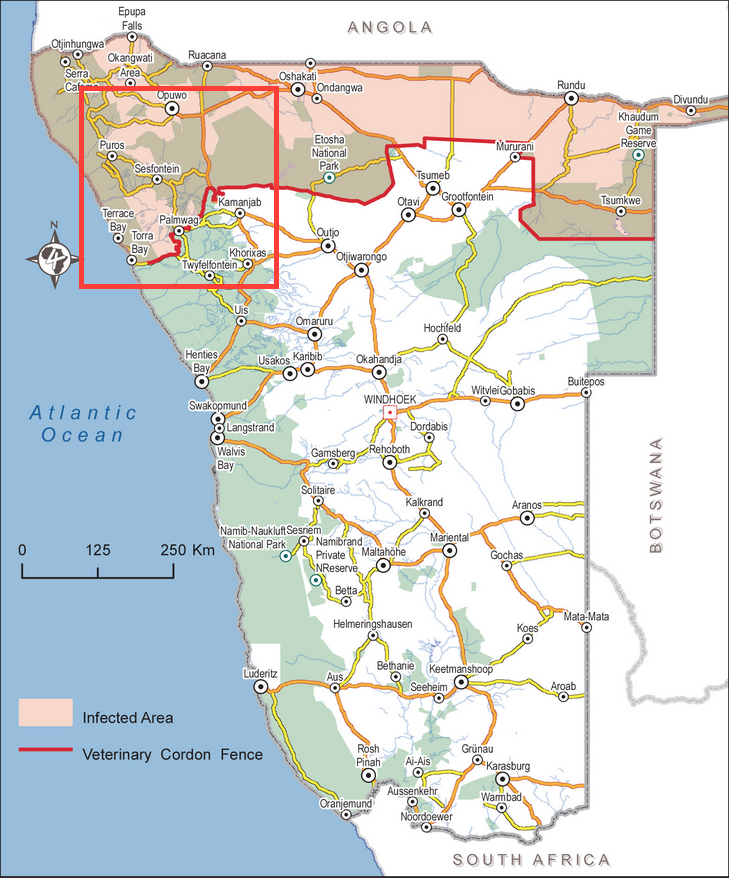
The last 160 desert-adapted black rhinos are both cornered and protected by the Red Line that divides the haves from the have-nots among Namibia’s farmers
The Red Line also prevents beef from cattle of the country’s 1.4-million-strong communal herds from being sold into lucrative foreign export markets. In August 2014, Agriculture Minister John Mutorwa told farmers in Omusati the government would move the fence up to the Angolan border, pending the eradication of foot-and-mouth disease and bovine pneumonia.
The Red Line also so far has kept cattle farmers out of the rhino ranges – but that looks set to change now as communal farmers have started moving their cattle south in close proximity to the fence. “The people hope to be the first to access grazing and waters in those areas,” said conservationist and part-time farmer Hendrik Mboroma.
Katuzuu Kapika and his clan of boisterous trouble-stirrers moved south into the Sesfontein area in late 2012 already – around the same time that Namibia Huanxin Resources Exploration and Development Company (NHRED) acquired two Exclusive Exploration Licences in the same area, Ministry of Mines and Energy records showed.
Licences 4306 and 4730 cover nearly 110,000 hectares – and two of the (previously) rhino-rich ranges of southern Kunene region west of Palmwag and west of Sesfontein. And wherever the Katuzuu Kapika cattle tracks intersected with NHRED’s mining activities, rhinos were being poached: 24 carcasses over 24 months, excluding two calves that later died.
When NHRED and its local partner, shop-owner and cattle farmer Efraim Muanyangapo, started bulldozing roads through welwitschia fields and cutting mining trenches next to the C43, the main public road into southern Kunene, alarm was raised.
The three biggest local communal conservancies, with the help of the Legal Assistance Centre, obtained an injunction against NHRED and Muanyangapo to stop their wild-cat mining, but the damage was done. In December 2012, the first fresh carcass was discovered in the area; over the next 18 months, 24 more would be found.
GROUND ZERO: MBAKONDJA AND STRUGGLE ROOTS
Tjiunda, the Himba cattleherder arrested in December 2012 for poaching a rhino cow close to a farmers’ settlement called Mbakondja, made a sworn statement to the police shortly afterwards saying his employer, Efraim Muanyangapo, had offered him N$30,000 to poach a rhino for its horns.
His guilt was clear – he had pointed the police to where he had hidden the horns and the gun he stole from a neighbour’s house. The two bullets for the Lee Enfield .303, stolen from his neighbour Jakotwa Tjiraso, were supplied by Muanygangapo, he stated.
However, once in court a year later, he withdrew his statement and was eventually sentenced to seven years in jail and a N$3,000 fine – far below the maximum prescribed sentence of 20 years and a N$100,000 fine the prosecutor had called for. Tjiunda’s defiance in court – lecturing everyone who testified against him – made it appear as if he knew he would not get the maximum sentence, the late well-known local conservationist Chris Eyre observed after the trial.
Muanyangapo, a cattle farmer from Omusati who owns a string of shebeens throughout the impoverished southern Kunene region and is also a key SWAPO organiser, denied the accusation. In late December 2014, another rhino cow was poached in the same area, and the spoor of the poachers tracked back to Muanyangapo’s house at Mbakondja. Although a large amount of cash was found in his car, no horns could be found. He remained under investigation, official sources said.
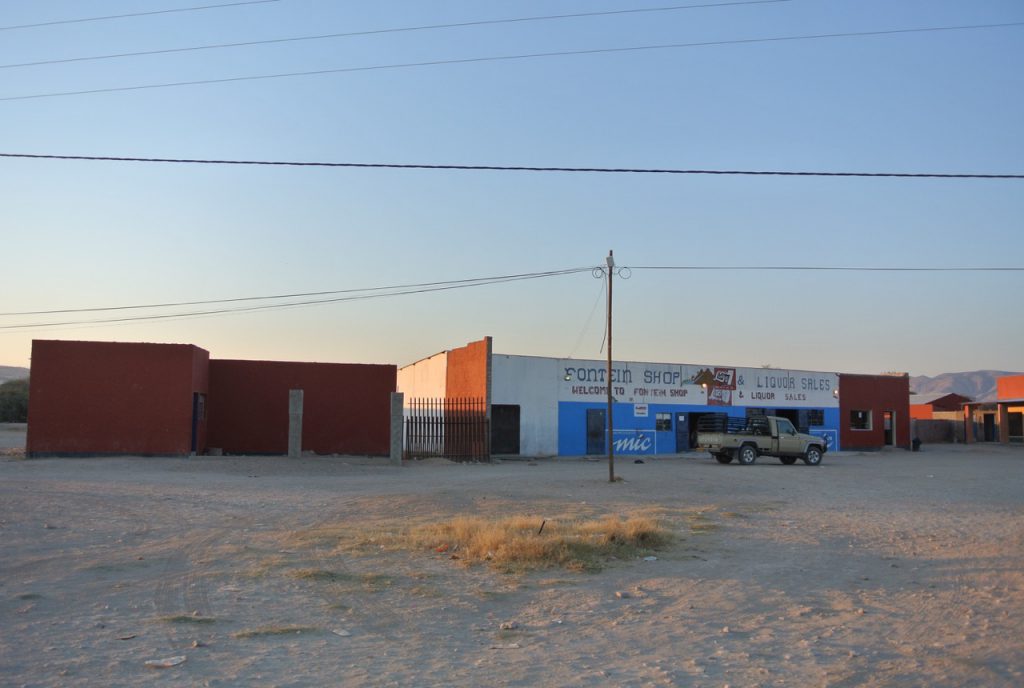
Efraim Muanyangapo’s and Paol Hao’s mini-shopping centre in Sesfontein, with one of Muanyangapo’s two new Land Cruisers outside
Tjiunda, it was established, was a former guide for SWAPO guerrillas during the liberation war, especially the former crack Typhoon unit. Investigation by anti-poaching experts showed that the rhino poachers were using the same anti-tracking techniques: using cattle to obliterate their tracks, a technique former Typhoon political commissar Mihe Gaomab confirmed they had taught the Himba cattle herders.
Over 10 months of investigation, a certain nexus started emerging: key suspects, officials and the poaching syndicates (which investigators believe number five or six) shared a common political history of either being members of or associated with SWAPO’s guerrilla army PLAN (Peo-ple’s Liberation Army of Namibia), members of the SWAPO Youth League and/or hailed from Omusati, or were associated with the Nujoma clique.
The MET until late 2014 were still in full denial about the extent of the poaching. At a meeting in early January with top management, Environmental Commissioner Teofilus Nghitila, who had issued the controversial environmental clearance permit to Muanyangapo and Hoa, repeatedly denied there was any poaching crisis.
Despite a N$100,000 reward for information leading to the arrest of the poachers, no-one attempted to claim the reward. When SWAPO swept the elections in December 2014, the local conservancies abandoned a legal effort to evict the Kapika clan from the area.
A NEW BROOM BRINGS BUSTS
In March 2015, the newly elected and reformist President Hage Geingob – the first non-Owambo president in SWAPO’s 52-year-long history – promoted the former MET deputy Pohamba Shifeta to MET Minister.
By now, the crisis could no longer be denied. But Shifeta immediately faced questions over his management record since 2012, notably over a hugely over-priced contract to repair the Etosha’s northern fence at a cost of N$2,000 a metre. Rhino mortalities in Etosha have continued to climb, to 68 at last count.
Shifeta admitted at a briefing that the police were investigating possible collusion between Etosha Park staff and the poachers, and an internal investigation was launched. The police also seized all rifles in the park for ballistic testing after spent cartridges of the 9.3x62mm calibre issued to game wardens were discovered buried at a poaching crime scene.

Minister of Environment and Tourism Pohamba Shifeta and previous Permanent Secretary Simeon Negumbo, now replaced by Dr Malan Lindeque
But then nature itself intervened: in early June, the dreaded foot-and-mouth disease erupted across the northern communal areas, forcing a quarantine of all communal livestock.
On June 15, police from Sesfontein and members of the Save the Rhino Trust apprehended five men at a checkpoint, shortly after they had killed one of the few remaining rhinos that had not been dehorned, also wounding her calf. Among the five was Gerson “Cash” Ndume, believed to be the ringleader. The horns, hidden inside a spare tyre, as well as a rifle, were confiscated.
Two local community game guards were also picked a few days later, and local police began questioning people associated with Muanyangapo.
A week later, police arrested 17 men from two villages close to the northern Etosha border, and charged them in the Okahao Magistrate’s Court with the hunting of six rhinos in the park. So far, bail has been denied and they are to appear in court again on July 30.
By mid-July, a total of 41 cattle-farmers and herders, mostly related to one another, were under arrest and 32 guns – including all rifles issued to Etosha game wardens ¬– were seized in and around the park, police said.
EPILOGUE: SLOW JUSTICE, COLD COMFORT FOR THE RHINOS
The trail of Li, Li, Pu and Wang was postponed for yet another time to the end of July, but sources close to the investigation said it was unlikely their trial would start then because investigations were still incomplete.
Xu Deijin, meanwhile, has absconded from Namibia, possibly via Angola with a second passport, official sources said.
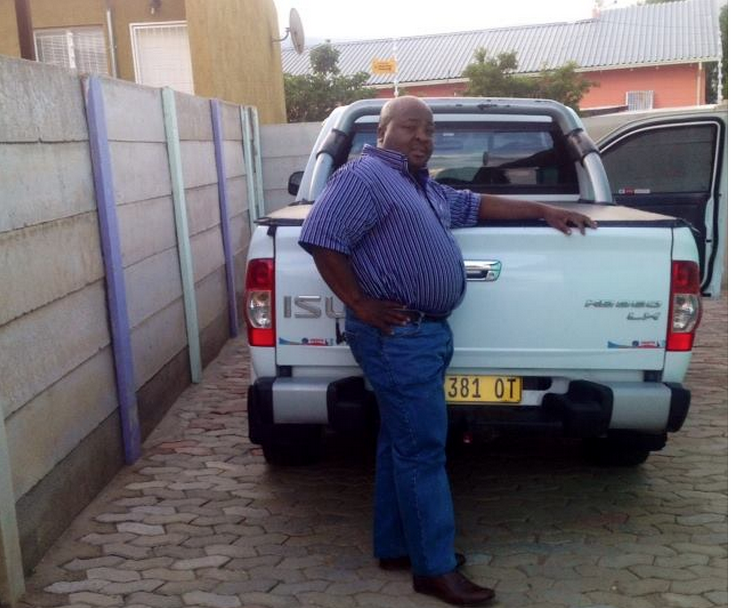
Former Etosha National Park boss Boas Erckie, now transferred to head office in Windhoek
The crisis in rhino poaching has prompted managerial changes at the MET, with Dr Malan Lindeque back to his former position as Permanent Secretary. Other significant changes include the transfer of Boas Erckie, Etosha Park director since 2009, and his brother Rehabeam to positions in Windhoek and Ondongua. Conservationists, however, have criticised the lack of any disciplinary action or investigation into their private farming interests.
Meanwhile, the rhino bull calf that survived the most recent poaching in Kunene died – a cold snap appeared to have been too much for it as it was being nursed back to health in Waterberg Plateau Park, in central Namibia.
In the battle between conservation and industrialisation, Namibia’s black rhinos appear to have become just another form of currency for acquiring more cattle and preserving face with Chinese partners.
John Grobler is an Associate of Oxpeckers Environmental Jouralism. This article was produced due to a grant provided by the Wits China-Africa Reporting Project at the Journalism Department of the University of the Witwatersrand. It was supported by Heinrich Bohmke, prosecutorial editor with ANCIR’s iLab.
Related links:
• Namibia’s secret ivory business
• Who are Namibia’s Chinese smugglers?

